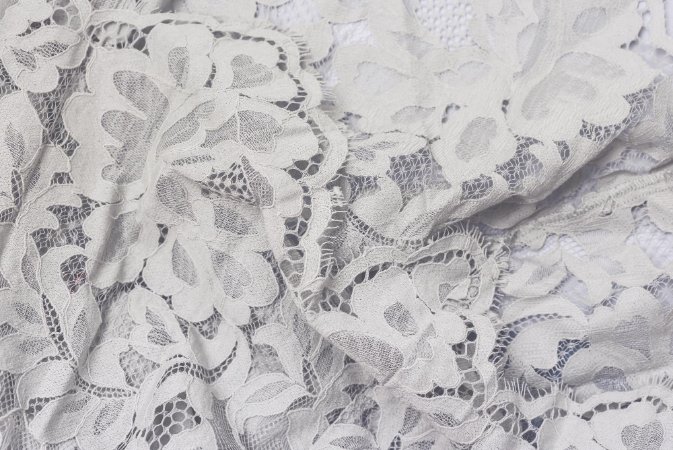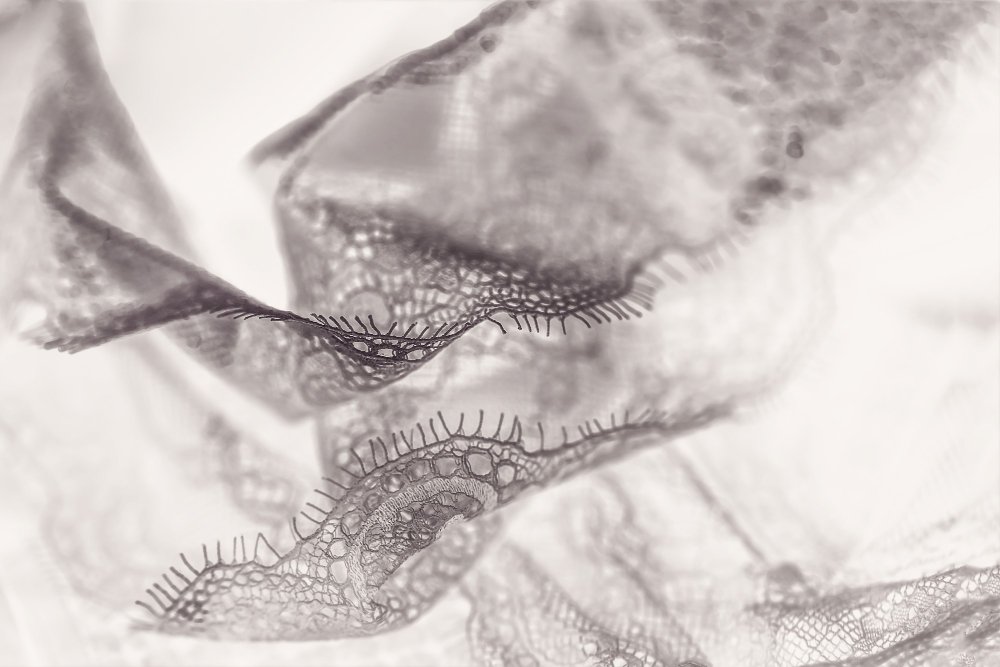Your ultimate resource for choosing, caring for, and working with stretch lace in fashion and home projects
Table of Contents
What is Stretch Lace Fabric?
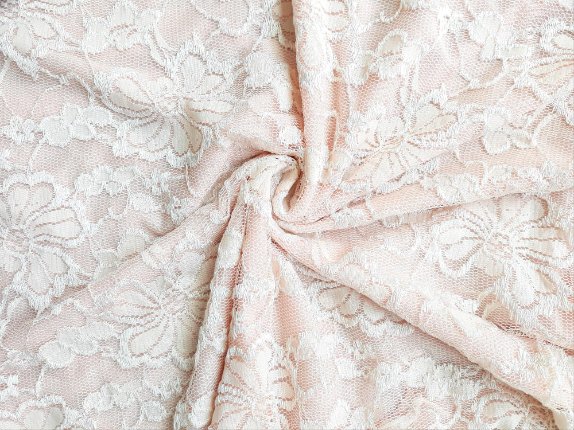
Stretch lace is a revolutionary textile innovation that solves an age-old problem in fashion design. While traditional lace fabric forced you to choose between delicate beauty and practical comfort, stretch lace gives you both.
This engineered material combines the intricate openwork patterns of classic lace with modern elastic fibers, creating a fabric that moves with your body while preserving every decorative detail. Unlike regular lace that can restrict movement or lose its shape, stretch lace adapts to your body’s curves and returns to its original form.
What is a Stretch Fabric?
A stretch fabric is any textile that can expand beyond its original dimensions and recover its shape when the tension is released. This elasticity comes from incorporating synthetic elastic fibers like spandex, elastane, or lycra into the fabric structure during manufacturing.
Traditional Lace
- Zero elasticity
- Prone to tearing under stress
- Limited pattern complexity
- Hand or simple machine production
- Natural fibers (cotton, silk, linen)
Stretch Lace Innovation
- Up to 150% stretch capacity
- Enhanced durability
- Complex multi-layer designs
- Computer-guided precision manufacturing
- Synthetic fiber blends
Composition and Types of Stretch Lace
What is the Composition of Stretch Lace Fabric?
Modern stretch lace typically combines multiple fiber types to achieve the perfect balance of beauty, stretch, and durability. Here’s what you’ll find in quality stretch lace:
| Fiber Type | Percentage | Purpose | Benefits |
|---|---|---|---|
| Polyester | 80-90% | Structure and pattern | Durability, color retention, easy care |
| Spandex/Elastane | 10-20% | Elasticity and recovery | Stretch, shape retention, comfort |
| Nylon | 0-15% | Strength enhancement | Tear resistance, smooth texture |
| Cotton (premium blends) | 5-25% | Breathability | Comfort, moisture absorption |
Types of Stretch Lace
Different manufacturing methods create distinct types of stretch lace, each with specific applications:
2-Way Stretch Lace
Stretches horizontally across the width. Ideal for trim applications, necklines, and sleeve accents.
4-Way Stretch Lace
Stretches both horizontally and vertically. Perfect for full garments, bodysuits, and fitted dresses.
Raschel Stretch Lace
Machine-knitted with finished edges. Commonly used for lingerie and delicate applications.
All-Over Stretch Lace
Wide panels for creating entire garments. Available in widths up to 60 inches.
Features and Design Characteristics
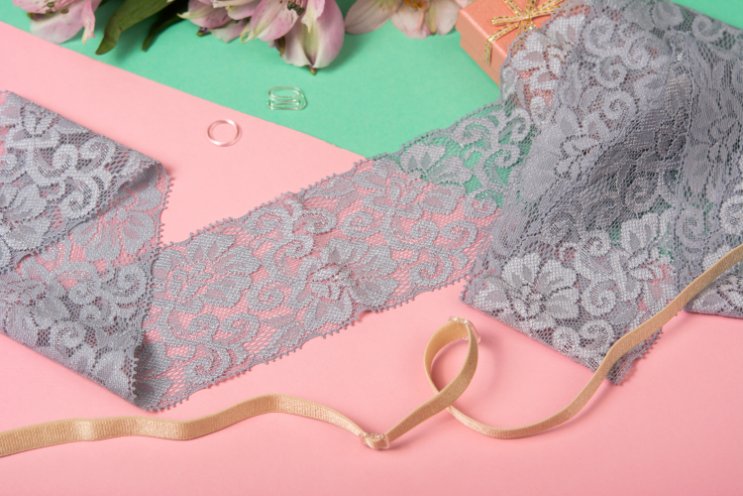
Flexibility and Performance
The magic of stretch lace lies in its engineered memory-like movement. Quality stretch lace can expand up to 150% of its original size before snapping back to its initial dimensions. This isn’t just about stretching – it’s about consistent, reliable recovery that maintains the fabric’s shape wash after wash.
The breathable construction prevents overheating through microscopic gaps in the weave. These openings allow airflow while maintaining coverage, making stretch lace comfortable for extended wear in layered outfits or form-fitting designs.
Pattern and Color Varieties
Modern stretch lace offers an incredible range of aesthetic options. From deep wine hues to metallic gold finishes, the color palette suits every season and style preference. Recent collections showcase innovative ombré effects that blend purple tones with silver glitter accents.
Pattern options include:
- Romantic florals: Rose motifs with 3D texture for classic femininity
- Geometric patterns: Lattices and abstract designs for modern aesthetics
- Digital prints: Compatible with laser cutting for contemporary applications
- Traditional motifs: Chantilly-inspired and guipure-style patterns
Width and Application Options
Width variations from 0.5 inches to 60 inches enable creative applications across all project types. Narrow trims perfect for accentuating necklines, while wider panels become statement sleeves or entire bodices. When you’re planning projects, consider how different widths interact when layered for dimensional effects.
Benefits and Modern Applications
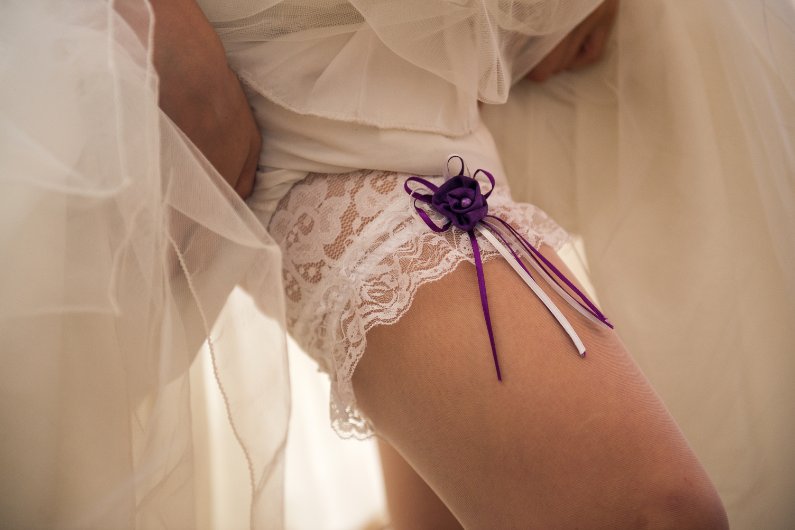
Enhanced Fit and Elegance
Garments crafted with stretch lace contour naturally to body shapes without requiring bulky seams. This eliminates the fitting challenges common with traditional decorative materials while maintaining intricate patterns. As one Broadway costume designer explains, “Dancers prefer it because it moves with them, not against them.”
The 50% expansion capability means garments flatter diverse figures while preserving luxurious details. You can create silhouettes that enhance your natural shape without sacrificing comfort or restricting movement.
What Do You Do with Stretch Lace?
Stretch lace’s versatility makes it suitable for numerous applications:
Apparel Applications
- Lingerie and intimate wear
- Bridal gown overlays and sleeves
- Evening wear bodices
- Dance and performance costumes
- Activewear accents
Home and Décor Uses
- Table runners and overlays
- Decorative pillows
- Light window treatments
- Craft and DIY projects
- Event décor elements
Design Harmony with Other Materials
Combining stretch lace with embroidered elements unlocks new creative possibilities. Raised embroidery stitches blend seamlessly with machine-woven patterns, allowing contrasting textures to coexist without visual clutter.
Recent runway shows demonstrate this balance beautifully. Sheath dresses feature embroidered lace sleeves paired with stretchable bodices, proving that functionality enhances rather than compromises artistry. These combinations reduce alteration needs while increasing garment longevity.
Complete Buying Guide

Quality Assessment Criteria
When you’re selecting stretch lace, focus on these key quality indicators:
| Quality Factor | What to Look For | Red Flags |
|---|---|---|
| Pattern Integrity | Clean, consistent motifs | Blurred or uneven designs |
| Stretch Recovery | Immediate return to shape | Slow recovery or permanent deformation |
| Edge Finish | Smooth, finished borders | Rough or fraying edges |
| Color Consistency | Even dye distribution | Blotchy or faded areas |
| Hand Feel | Soft, flexible texture | Stiff or scratchy surface |
Project-Specific Selection Guide
Interactive Stretch Lace Calculator
Project Yardage Calculator
Calculate how much stretch lace you need for your project:
Fabric Stretch Tester Guide
Test Your Lace Stretch Percentage
6 inches = 50% stretch (Good)
8 inches = 100% stretch (Excellent)
10+ inches = 150%+ stretch (Superior)
Understanding Fabric Specifications
Professional specifications help you make informed choices:
- GSM (Grams per Square Meter): 80-200 GSM for apparel, 50-120 GSM for trim
- Stretch percentage: 25-50% for moderate stretch, 50%+ for high stretch
- Weight classification: 4 oz per square yard is standard for most applications
- Width availability: Standard 58″-60″ for apparel, custom widths available
Care and Maintenance
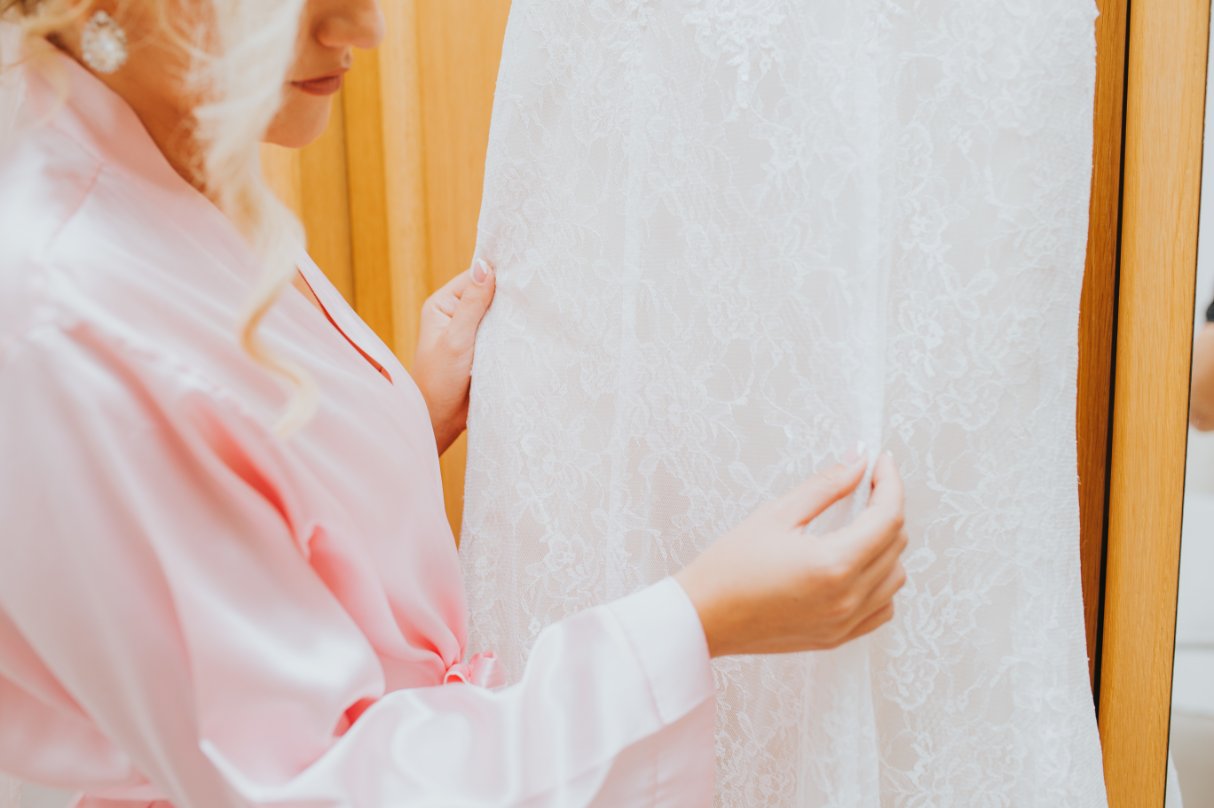
How to Wash Stretch Lace
Proper care ensures your stretch lace maintains its beauty and elasticity for years. Here’s your complete care guide:
Machine Washing
Water: Cold water only
Cycle: Gentle or delicate
Protection: Use mesh lingerie bag
Detergent: Mild, no bleach
Hand Washing
Method: Gentle agitation
Soaking: Maximum 15 minutes
Rinsing: Thorough, cool water
Squeezing: Never wring or twist
Drying
Best method: Lay flat on towel
Location: Away from direct sunlight
Machine drying: Cool setting only
Time: Remove while slightly damp
Storage
Folding: Gentle, minimal creasing
Hanging: Padded hangers only
Environment: Cool, dry location
Protection: Avoid snag-prone surfaces
Can You Iron Stretch Lace?
Ironing stretch lace requires extreme caution due to the synthetic fibers that can melt under high heat. If you must iron:
1. Set iron to lowest heat (nylon/synthetic setting)
2. Use a press cloth or cotton fabric barrier
3. Test on an inconspicuous area first
4. Never apply direct heat to stretch fibers
5. Work quickly with light pressure
6. Let fabric cool completely before moving
How to Get Wrinkles Out of Lace
Alternative methods work better than traditional ironing:
- Steam method: Hang in a steamy bathroom for 10-15 minutes
- Gentle stretching: Lightly stretch while damp to smooth wrinkles
- Fabric relaxer: Use commercial fabric relaxing sprays
- Professional steaming: Best option for valuable pieces
How to Soften Lace Fabric
If your stretch lace feels stiff, try these gentle softening methods:
- Add fabric conditioner to the final rinse cycle
- Use white vinegar (1/4 cup per load) as a natural softener
- Air dry rather than machine dry for softer texture
- Avoid over-washing, which can break down fibers
Sewing Techniques and Tips
How to Sew Stretch Lace
Working with stretch lace requires specific techniques to prevent damage and ensure professional results. Here’s your complete sewing guide:
Essential Equipment
| Tool | Specification | Purpose |
|---|---|---|
| Needle | Ballpoint/Stretch 75/11 | Prevents snagging delicate fibers |
| Thread | Polyester or cotton/poly blend | Matches fabric stretch properties |
| Presser Foot | Walking foot or Teflon foot | Smooth fabric feeding |
| Stabilizer | Tear-away or wash-away | Prevents stretching during sewing |
What is the Best Needle for Stretch Lace?
A ballpoint or stretch needle size 75/11 is ideal for most stretch lace projects. The rounded tip separates fibers instead of piercing them, preventing runs and snags. For heavier stretch lace, consider size 90/14, while delicate laces may require size 70/10.
Stitch Selection and Techniques
Best Stitches for Stretch Lace
- Zigzag stitch: Basic stretch accommodation
- Overlock stitch: Professional finish
- Triple zigzag: Maximum stretch retention
- Stretch stitch: Built-in elasticity
Stitches to Avoid
- Straight stitch: Can break under stress
- Tight tension: Causes puckering
- Long stitches: Poor stretch recovery
- Heavy topstitching: Reduces elasticity
Advanced Sewing Techniques
Professional techniques for working with stretch lace:
• Let fabric relax for 18-24 hours before cutting
• Use pattern weights instead of pins
• Consider pre-washing for shrinkage
• Test stitches on fabric scraps first
How to Use Stretch Lace Seam Binding
Stretch lace seam binding provides a professional finish for garment edges:
- Cut binding strips on the stretch grain
- Apply with gentle, consistent tension
- Use a zigzag stitch for attachment
- Press lightly with low heat if needed
Pattern Matching and Layout
When working with patterned stretch lace, careful layout ensures professional results:
- Plan pattern placement before cutting
- Consider stretch direction in pattern layout
- Match patterns at visible seam lines
- Allow extra fabric for pattern matching
Troubleshooting Common Issues
Does Stretch Lace Fray?
Stretch lace generally frays less than traditional lace due to its knitted construction and synthetic fiber content. However, cut edges may still require finishing:
Minimal Fraying
Most stretch laces with finished edges require no additional treatment for normal use.
Edge Finishing Options
Zigzag stitch, serging, or bias binding for cut edges that will see stress.
Prevention Tips
Use sharp scissors, cut with the grain, and handle gently during construction.
Repair Methods
Small snags can often be worked back through the fabric with a needle.
How to Tighten Stretch Laces
If your stretch lace has become loose over time, try these restoration methods:
- Gentle heat treatment: Warm (not hot) wash followed by low-heat drying
- Steam restoration: Professional steaming can help restore elasticity
- Elastic insertion: Add narrow elastic to key areas for support
- Sizing adjustment: Take in seams if fabric has permanently stretched
Common Sewing Problems and Solutions
| Problem | Cause | Solution |
|---|---|---|
| Skipped stitches | Wrong needle type | Switch to ballpoint/stretch needle |
| Fabric puckering | Tension too tight | Reduce thread tension, use stabilizer |
| Seam popping | Non-stretch stitch used | Use zigzag or stretch stitch |
| Pattern distortion | Overstretching during sewing | Support fabric weight, gentle handling |
For more detailed sewing troubleshooting, check our sewing machine troubleshooting guide and learn about seam allowance troubleshooting.
Project-Specific Applications
Lingerie and Intimate Wear
Stretch lace revolutionizes intimate apparel construction. You can create pieces that combine visual appeal with day-long comfort. The key considerations for lingerie projects include:
Video tutorial: Learn professional techniques for sewing stretch lace in lingerie construction
- Support structure: Combine with stretch fabrics for adequate support
- Seam placement: Position seams to avoid pressure points
- Edge finishing: Use fold-over elastic or stretch binding
- Hardware compatibility: Choose findings that accommodate stretch
Bridal and Formal Wear
Modern brides appreciate the comfort that stretch lace brings to their special day. When designing bridal pieces:
Bridal Considerations
- Color matching with other laces
- Photography considerations (how patterns read)
- Movement for dancing and ceremony
- Undergarment compatibility
Design Applications
- Form-fitting bodices
- Comfortable long sleeves
- Flexible overlay panels
- Stretch illusion necklines
When working with bridal stretch lace, consider how it interacts with other traditional lace types in the same garment. The stretch properties should complement, not compete with, non-stretch elements.
Activewear and Performance Garments
Athletic applications require specific performance characteristics:
- Moisture management: Look for treated polyester blends
- UV protection: Relevant for outdoor activity wear
- Compression levels: Match to activity requirements
- Durability: Higher spandex content for frequent washing
Home Décor Applications
Stretch lace adds elegance to home projects while offering practical benefits:
- Table runners: Conform to table shapes, easy to launder
- Pillow accents: Stretch over different pillow sizes
- Window treatments: Light filtering with graceful drape
- Craft projects: Forgiving material for beginner sewers
Cost Analysis and Value
Price Range Analysis
Understanding stretch lace pricing helps you make budget-appropriate choices for your projects:
| Quality Level | Price Range (per yard) | Characteristics | Best Use |
|---|---|---|---|
| Budget | $6-10 | Basic patterns, standard stretch | Practice projects, craft items |
| Mid-range | $10-20 | Good quality, varied designs | Everyday garments, home décor |
| Premium | $20-40 | Superior stretch, complex patterns | Special occasion wear, bridal |
| Designer | $40+ | Exclusive designs, luxury blends | Haute couture, investment pieces |
Value Considerations
When evaluating stretch lace value, consider total project cost including:
- Yardage requirements: Stretch properties may reduce needed amounts
- Lining needs: Some stretch laces work without additional lining
- Findings costs: Specialized notions for stretch construction
- Longevity: Quality stretch lace lasts longer than budget alternatives
• Buy in bulk for multiple projects (50+ yards often qualify for discounts)
• Check for end-of-bolt sales at fabric stores
• Consider coordinating colors for versatile project options
• Compare online vs. brick-and-mortar pricing including shipping
Quality vs. Price Assessment
Higher prices don’t always guarantee better quality. Focus on these factors when comparing options:
- Stretch recovery consistency across the fabric width
- Pattern clarity and registration
- Color fastness and fade resistance
- Edge finish quality and durability
- Manufacturer reputation and customer reviews
Frequently Asked Questions
Yes, most stretch lace can be machine washed on a gentle cycle with cold water. Always use a mesh lingerie bag to protect the delicate fibers and avoid snagging. Check the manufacturer’s care label for specific instructions, as some luxury blends may require hand washing.
Stretch lace adapts to body movements and natural size fluctuations throughout the day. This reduces pressure points, prevents binding, and maintains shape even during active wear. The inherent flexibility eliminates the need for loose-fitting designs to accommodate movement.
Contemporary stretch lace comes in an extensive palette including classic neutrals (white, ivory, black), bold fashion colors (wine, emerald, royal blue), and specialty finishes (metallic threads, glitter accents, ombré effects). Seasonal collections often feature trending colors aligned with fashion forecasts.
Absolutely. Modern manufacturing techniques allow embroidered elements to be incorporated during the stretch lace production process. This ensures the embroidery moves with the base fabric without compromising stretch or creating stress points.
Stretch lace excels in form-fitting applications including lingerie, activewear, dancewear, and evening wear. It’s particularly valuable for garments requiring both aesthetic appeal and functional performance, such as figure-skating costumes or fitted formal wear.
Polyester enhances durability, color retention, and care ease while maintaining affordability. The polyester component provides structure for complex patterns, while elastane adds stretch. This combination offers excellent value for most applications.
Yes, stretch lace is available in widths from 0.5 inches (for trim applications) up to 60 inches (for full garment construction). Medium widths (6-12 inches) are popular for sleeves and bodice panels, while narrow widths work well for finishing touches.
2-way stretch lace extends only in one direction (usually width-wise), making it suitable for trim and accent applications. 4-way stretch lace extends both horizontally and vertically, providing maximum flexibility for fitted garments and complex draping.
Proper care is essential: wash in cool water, avoid high heat when drying, store without tension, and handle gently during construction. Quality stretch lace with higher elastane content typically maintains elasticity longer than budget alternatives.
Definitely! Stretch lace works beautifully for table runners, decorative pillows, window treatments, and craft projects. The stretch properties allow it to conform to different shapes and sizes, while the openwork design adds elegance to home spaces.
Conclusion
Your Next Steps with Stretch Lace
Stretch lace represents a perfect fusion of traditional craftsmanship and modern innovation. This comprehensive guide has equipped you with the knowledge to select, care for, and work with stretch lace successfully across a wide range of projects.
Key Takeaways
Remember these essential points as you embark on your stretch lace projects:
- Quality matters: Invest in good-quality stretch lace for projects requiring durability and consistent performance
- Care extends life: Proper washing and storage maintain elasticity and appearance for years
- Technique is crucial: Use appropriate needles, stitches, and handling methods for professional results
- Versatility opens possibilities: Don’t limit stretch lace to traditional applications – explore creative uses
Expert Recommendations
Based on current industry trends and user feedback, here are our top recommendations:
For Beginners
- Start with medium-weight, 2-way stretch lace
- Choose forgiving patterns without complex matching
- Practice on samples before cutting your main fabric
- Consider taking a lace sewing class for hands-on learning
For Advanced Sewers
- Experiment with 4-way stretch for fitted garments
- Combine multiple lace types in single projects
- Explore unconventional applications and techniques
- Share your innovations with the sewing community
Future Trends and Innovations
The stretch lace industry continues evolving with exciting developments on the horizon:
- Sustainable options: Bio-based elastane and recycled fiber blends
- Smart fabrics: Moisture-wicking and temperature-regulating properties
- Customization: Digital printing and on-demand pattern creation
- Performance enhancement: Improved stretch ratios and recovery times
Building Your Stretch Lace Collection
Consider building a versatile stretch lace stash with these essentials:
- White and black stretch lace in multiple widths
- Nude/skin-tone options for undergarments
- One luxury piece for special projects
- Coordinating colors for your frequent project types
- Both 2-way and 4-way stretch varieties
Final Thoughts
Stretch lace offers unlimited creative possibilities for both novice and experienced makers. Whether you’re crafting intimate apparel, elegant evening wear, or unique home décor items, understanding the properties and applications of stretch lace will elevate your projects to professional standards.
The combination of beauty, comfort, and functionality makes stretch lace an invaluable addition to any fabric collection. As you explore the possibilities, remember that experimentation and practice lead to mastery. Don’t be afraid to try new techniques and push the boundaries of traditional applications.
For additional inspiration and technical guidance, explore our related resources on cotton lace fabric, knitted lace varieties, and fundamental sewing techniques. The world of stretch lace awaits your creativity!
References and Further Reading:
- Sewport Lace Fabric Directory – Comprehensive lace manufacturing information
- Tissura Stretch Fabric Guide – Technical stretch fabric specifications
- MasterClass Lace History Guide – Historical context and traditional techniques


